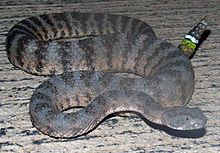- Crotalus tigris
-
Crotalus tigris 
Conservation status Scientific classification Kingdom: Animalia Phylum: Chordata Subphylum: Vertebrata Class: Reptilia Order: Squamata Suborder: Serpentes Family: Viperidae Subfamily: Crotalinae Genus: Crotalus Species: C. tigris Binomial name Crotalus tigris
Kennicott, 1859Synonyms - Crotalus tigris - Kennicott In Baird, 1859
- C[audisona]. tigris - Cope, 1867
- Crotalus tigris - Boulenger, 1896
- Crotalus tigris tigris - Amaral, 1929[1]
- Common names: tiger rattlesnake, tiger rattler.[2]
Crotalus tigris is a venomous pit viper species found in the southwestern United States and northwestern Mexico. No subspecies are currently recognized.[3] The specific name is Latin for tiger and is an allusion to many narrow dorsal crossbands that create a pattern of vertical stripes.[4]
Contents
Description
A relatively small species, adults reach less than 100 cm in length. The largest specimen on record measured 88.5 cm (Klauber, 1956). Proportionally, the head is small and the rattle is large.[4]
The color pattern consists of a gray, lavender, blue-gray, pink or buff ground color that usually turns to pink, pale orange or cream on the sides. This is overlaid with a series of 35-52 crossbands that are dark gray or brown in color and consist mainly of heavy punctations. These crossbands have vague borders and are wider dorsally than latterally. Also middorsally, the crossbands become wider than the spaces that separate them. Posteriorly, the crossbands also become darker and more clearly defined. The markings on the head are mostly vague and irregular, although towards the rear, a few dark markings may be arranged as paired occipital blotches and upper temporal streaks. [4]
Geographic range
C. tigris is found in the southwestern United States in south-central Arizona, in northwestern Mexico in Sonora, and on Isla Tiburón in the Gulf of California. The type locality is described as "Sierra Verde and Pozo Verde". The latter is a spring located on the Sonora side of the US-Mexico border, near Sasabe. According to Stejneger (1893), this spring is on the western slope of the southern Sierra Verde, which is also known as the Sierra del Pozo Verde.[1]
Conservation status
This species is classified as Least Concern (LC) on the IUCN Red List of Threatened Species (v3.1, 2001).[5] Species are listed as such due to their wide distribution, presumed large population, or because it is unlikely to be declining fast enough to qualify for listing in a more threatened category. The population trend was stable when assessed in 2007.[6]
Venom
Although it has a comparatively low venom yield, according to Weinstein and Smith (1990), its toxicity is considered to be the highest of all rattlesnake venoms. It has a high neurotoxic fraction that is antigenically related to Mojave toxin (see Crotalus scutulatus, venom A), and includes another component that is immunologically identical to crotamine, which is a myotoxin also found in tropical rattlesnakes (see Crotalus durissus). There is low, but significant protease activity in the venom, although there does not seem to be any hemolytic activity.[7]
Brown (1973) lists an average venom yield of 11 mg (dried venom) and an LD50 value of 0.6 mg/kg IP for toxicity.[8]
Essentially no information available for bite symptoms. Despite the low venom yield, a bite by this or any rattlesnake should be considered a life-threatening medical emergency. [7]
See also
- List of crotaline species and subspecies
- Crotalus by common name
- Crotalus by taxonomic synonyms
- Crotalinae by common name
- Crotalinae by taxonomic synonyms
- Snakebite
References
- ^ a b McDiarmid RW, Campbell JA, Touré T. 1999. Snake Species of the World: A Taxonomic and Geographic Reference, vol. 1. Herpetologists' League. 511 pp. ISBN 1-893777-00-6 (series). ISBN 1-893777-01-4 (volume).
- ^ Wright AH, Wright AA. 1957. Handbook of Snakes. Comstock Publishing Associates. (7th printing, 1985). 1105 pp. ISBN 0-8014-0463-0.
- ^ "Crotalus tigris". Integrated Taxonomic Information System. http://www.itis.gov/servlet/SingleRpt/SingleRpt?search_topic=TSN&search_value=174318. Retrieved 16 May 2007.
- ^ a b c Campbell JA, Lamar WW. 2004. The Venomous Reptiles of the Western Hemisphere. Comstock Publishing Associates, Ithaca and London. 870 pp. 1500 plates. ISBN 0-8014-4141-2.
- ^ Crotalus tigris at the IUCN Red List. Accessed 13 September 2007.
- ^ 2001 Categories & Criteria (version 3.1) at the IUCN Red List. Accessed 13 September 2007.
- ^ a b Norris R. 2004. Venom Poisoning in North American Reptiles. In Campbell JA, Lamar WW. 2004. The Venomous Reptiles of the Western Hemisphere. Comstock Publishing Associates, Ithaca and London. 870 pp. 1500 plates. ISBN 0-8014-4141-2.
- ^ Brown JH. 1973. Toxicology and Pharmacology of Venoms from Poisonous Snakes. Springfield, Illinois: Charles C. Thomas. 184 pp. LCCCN 73-229. ISBN 0-398-02808-7.
External links
- Crotalus tigris at the Reptarium.cz Reptile Database. Accessed 12 December 2007.
- Crotalus tigris images at California Reptiles and Amphibians. Accessed 16 May 2007.
- Crotalus tigris at Reptiles and Amphibians of Arizona. Accessed 16 May 2007.
Categories:- IUCN Red List least concern species
- Crotalus
- Fauna of Gulf of California islands
Wikimedia Foundation. 2010.


